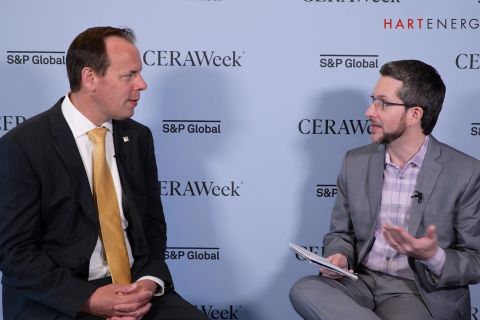During the first 11 months of 2003, the combination of strong fundamentals, unit-distribution increases and a historically low interest-rate environment resulted in solid investment performance by energy-related master limited partnerships (MLPs). This is according to Ronald F. Londe, vice president, equity research, and a specialist in MLPs and royalty trusts for A.G. Edwards & Sons in St. Louis. The analyst notes that during this period, the firm's energy-related MLP coverage universe-comprised of 11 midstream/pipeline partnerships, three coal partnerships and six propane-distribution partnerships-generated a total return (price appreciation plus reinvested distributions) of 50.2%. This compares with total returns of 22.3% for the S&P 500 Index, 32% for the S&P REIT (real estate investment trust) Composite Index and 44.3% for the Russell 2000 Index. "Fundamentally, 2004 should again be a favorable year for [such] MLPs," says Londe. "A general economic recovery, minor tariff increases and internal growth projects at certain partnerships should allow for an increase in cash flow available for distribution among midstream/pipeline MLPs." Meanwhile, stronger economic activity, high gas prices and relatively low coal inventories should enable coal partnerships to enjoy firm-to-higher prices, which should translate into growing unit distributions. Propane partnerships, he says, will be influenced by 2003-04 winter conditions, backstopped by a trend toward continued firm margins. Londe observes that legislation allowing mutual funds to more readily invest in MLPs has been shelved until early 2004. However, if this legislation is enacted, institutional interest in such partnerships could enhance unit-price appreciation. This aside, the analyst believes that within the energy-related partnership sector, acquisition activity should continue to enhance unit-distribution growth. "After a lull in such activity during 2003 for equity financing that strengthened balance sheets, these MLPs are well positioned to accelerate acquisitions in 2004." Indeed, Enterprise Products Partners just announced the estimated $3.6-billion acquisition of GulfTerra Energy Partners, due to close in second-half 2004. Londe cautions, however, that with fewer acquisitions made during 2003, especially among the larger midstream/pipeline partnerships, unit cash flow growth could be less dramatic in 2004. He notes that during 2002, energy-related MLPs acquired $7.2 billion in assets. Comparatively, through the first 11 months of 2003, only $960 million worth of acquisitions closed, with total acquisitions by year-end 2003 expected to total just $1.2 billion. In addition, the midstream/pipeline sector will have to cope with rising maintenance, insurance and G&A costs. Also, if interest rates rise in 2004, partnerships with significant short-term, floating-rate debt could experience higher interest expense. And, if interest rates do rise significantly in 2004, that could dampen investor sentiment toward the sector. "Close to 80% of the change in MLP valuations can be linked to directional changes in interest rates," explains Londe. "Should the 10-year Treasury-note yield rise to the 5.5% to 6.5% range, investor psychology would make positive relative performance difficult for MLPs-and rates in the 6.5% to 7% range have historically been very negative for MLP relative performance." An economist at A.G. Edwards expects the 10-year Treasury-note yield to rise from a recent 4.4% to around 5% by mid-2004, then move somewhat higher before retracting to the 5% level toward the end of the year. Says Londe, "Given the level of recent MLP yields-around 7%-it's very difficult to justify selling such partnership units, paying the tax liability, placing the proceeds in a lower-yield money-market fund, waiting for MLPs to decline in market value while interest rates rise, then reinvesting in another MLP at hopefully a lower price-not unless interests rates move up at least 100 to 125 basis points." The best way for income-oriented investors to approach this sector? "Design a diversified portfolio by selecting partnerships from differing sectors," he says.
Recommended Reading
Williston Warriors: Enerplus’ Long Bakken Run Ends in $4B Chord Deal
2024-02-22 - Chord Energy and Enerplus are combining to create an $11 billion Williston Basin operator. The deal ends a long run in the Bakken for Enerplus, which bet on the emerging horizontal shale play in Montana nearly two decades ago.
Exclusive: Is TG Natural Resources Looking to Snap Up More?
2024-03-27 - At Hart Energy's DUG Gas+ Conference and Expo in Shreveport, Louisiana, TG Natural Resources' President and CEO Craig Jarchow said the integration of the Rockcliff Energy acquisition is well underway and that "being acquisitive is certainly" in the company's future.
Exclusive: Frank Tsuru Reflects on Indigo's History, Impact in the Haynesville
2024-04-11 - Frank Tsuru, president and CEO of Momentum Midstream and former CEO of Indigo Natural Resources, looks back at the early stages of Haynesville development and the Indigo-Southwestern deal, in this Hart Energy Exclusive interview.
Exclusive: Rockcliff CEO on $2.7B TGNR Deal, Value of Haynesville M&A
2024-04-10 - Rockcliff Energy CEO and President Alan Smith discusses the ups and downs of executing the transaction with TG Natural Resources and what's on the Rockcliff III radar, in this Hart Energy Exclusive interview.
Exclusive: Pat Jelinek on Decarbonization Efforts, M&A Outlook
2024-04-16 - Oil and gas leader for EY Americas Pat Jelinek discusses trends in the Lower 48 like consolidation and why decarbonization is "more important" in the near term than the energy transition, in this Hart Energy Exclusive interview.





